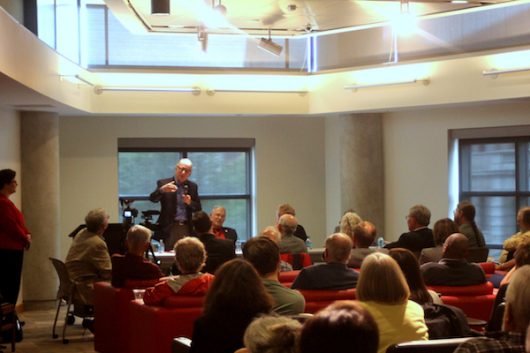
Author, Ohio State faculty member and alumnus Bill Shkurti speaks on his book, “The Ohio State University in the Sixties: The unraveling of the old order,” in Thompson Library on Sept. 30. Credit: Grace Fleisher | Lantern Reporter
In May 1970, Ohio State remained closed for nearly two weeks following crowds demonstrating over an array of political issues and inequalities.
On Friday evening in Thompson Library, Bill Shkurti — who graduated from OSU in the ’60s and worked in the OSU administration in the ’70s — discussed the closure and the decade of events that lead up to it in a presentation on his newly published book, “The Ohio State University in the Sixties: The unraveling of the old order.” Also included in the discussion was its relevance to campus life today and comments from panelists Niki Schwartz, Bill Crandell and Mabel Freeman, all of whom were students in the ’60s.
Shkurti began the discussion with a goofy demeanor.
“If you would, put on your tie-dye T-shirts and bell-bottom jeans and join me for a magical mystery tour,” he said.
Shkurti, now an adjunct faculty member of the John Glenn College of Public Affairs, quickly went into a more serious tone throughout the remainder of the discussion and began by tackling what he listed as the five prevalent issues presented in his book.
“The book is chronological and it begins much as five trains do, picking up speed as the years went on,” Shkurti said. “The issues at the time were African Americans being unwelcome, the inequality of women, the limit of free expression/debate as well as new students every year with differing opinions.”
Following Shkurti’s introduction, panelists presented their opinions on the book and shared stories from their time at the university.
Schwartz, president for Students of Liberal Action during 1962-63, worked tediously during his time at the university on student’s access to freedom of expression. The university used what it called the “speaker’s rule,” which allowed the university president to veto anyone invited by students to speak at OSU.
“We tried to have Frank Wilkinson speak at the university but (OSU) President (Novice) Fawcett wouldn’t allow it,” Schwartz said. Wilkinson became a controversial figure when, during the Red Scare of the 1950s, he refused to tell the House Un-American Activities Committee if he was a Communist.
Schwartz would later serve as a plaintiff in a lawsuit which argued the speaker’s rule violated the First Amendment, though OSU abandoned the rule before the case was heard in an appeals court.
While many students were politically engaged in the times, a large majority were not. Freeman, president of the Women’s Self Government Association from 1965 to 1966, considered herself to be one of those individuals.
“Women going to college in the ’60s was a coming of age” Freeman said. “As we became more aware of what was happening, things changed.”
Crandell, one of the leaders of the 1970 protests, said that as times have changed, so have students, and so has the college experience.
“I think a lot of people think a college education is just academic and I think a lot of people miss their education that way,” said Crandell, who was a leader in some of the protests during his time at OSU.
“Change is always a constant,” he said. “Universities change with the times, and they need to make sure they don’t have a sense of complacency when doing so.”


